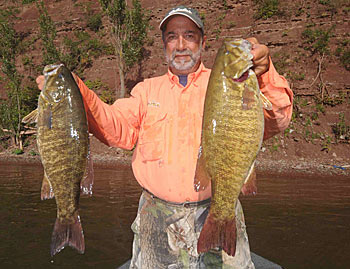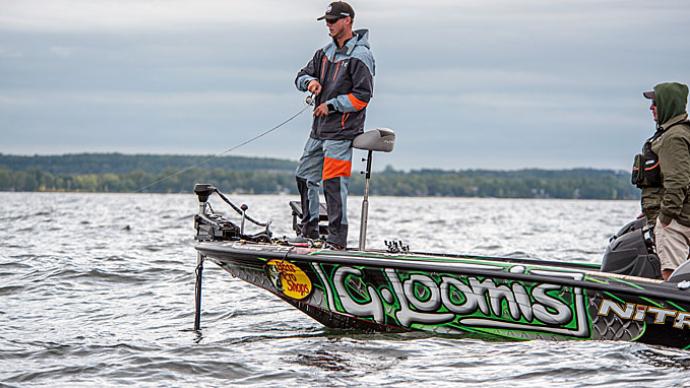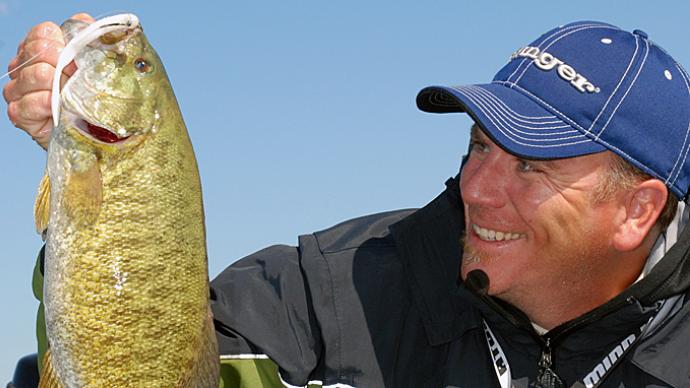
When Terry Jones takes his clients on guide trips in the fall, he offers them plenty of options for catching smallmouth bass.
The New York guide offers smallmouth trips on Lake Erie, Lake Ontario, the Niagara River, and New York inland lakes through his First Class Bass Charters service (716-875-4946).
As water temperatures begin to drop in the early fall, Jones still keys on summertime smallmouth havens such as deep rock piles and deep points in the Great Lakes and the Niagara River. “My key to everything is my electronics,” Jones says. “I spend a lot of time looking for my fish.” Jones relies on his Lowrance sonar and electronic mapping system to find bass on the rock piles, points, and reefs as deep as 30 to 50 feet. He will fish shallower structure (around 14 feet deep) at the mouth of the Niagara River and pockets of the river if current is present.
When fishing the deep structure, Jones favors 2 1/2- or 3 1/2-inch Strike King tube baits in green pumpkin. “I like green pumpkin, especially if I can get some purple flake in it,” he says.
The guide pours his jigheads and prefers matching his tubes with a football head to imitate the bulging head of a goby. He uses jigheads with 4/0 Mustad Ultra Point hooks for his 3 1/2-inch tubes and downsizes to a jighead with a 2/0 Mustad hook for his smaller tubes.
Jones opts for jigheads ranging in size from 1/4 to 1/2 ounce but says he relies on a 3/8-ounce jig “75 percent” of the time. He modifies his bait by shrink-wrapping a Venom Lures glass rattle to the shaft of the jig’s hook.
Two retrieves work best for Jones when presenting his tube baits to smallmouth. “Some days, I can just drag it, but I mostly like to pop the rod about 4 to 6 inches,” he says. When hopping his tube, Jones watches for his line to go slack, which indicates a strike because smallmouth usually hit the lure on the fall. The New York angler retrieves his tubes with a 6-foot, 9-inch, or 7-foot medium or medium-heavy spinning rod and a spinning reel spooled with 8- or 10-pound Seaguar Fluorocarbon line.

The river offers shallower options for Jones and his clients throughout the fall. “The good green weeds draw the smallies in then,” says Jones, who also targets the shallows of islands on the lakes and the river. Smallmouth in the river will either be hanging in the weeds 6 to 12 feet deep or in the river's holes at depths of 20 feet or deeper.
Jones tempts bass in the weeds with a tube bait on a 1/4-ounce jighead, or he will burn a 1/2- or 3/4-ounce Strike King spinnerbait with a chartreuse skirt and chartreuse tandem willowleaf blades around the vegetation. He favors throwing the spinnerbait on a 7-foot medium-heavy casting rod and a high-speed baitcast reel filled with a main line of 20- to 30-pound Seaguar braid and a 10-pound leader of Seaguar Fluorocarbon.
Smallmouth will remain on deep structure throughout the fall because their primary forage of gobies always stays on the rocky bottom. However, some smallmouth bass start schooling in the fall and roam around in pursuit of emerald shiners and alewives. Jones usually finds these fish in the river and tempts them with 3- or 4-inch suspending stickbaits in natural baitfish and perch hues or the clown color.
A jerk-and-pause retrieve works best for Jones when he presents a suspending stickbait to roaming smallmouth. He usually starts with three jerks and a pause, but if this retrieve fails to trigger strikes, he will vary the cadence. His gear for jerking stickbaits consists of a 6 1/2- or 6-foot, 9-inch medium action spinning rod and spinning reel filled with a main line of 20- to 30-pound Seaguar braid and an 8- to 10-pound leader of Seaguar Fluorocarbon.
By late fall, Jones resorts to drop-shotting the deep structure of Lake Erie to catch smallmouth rising off the bottom to feed. He usually rigs his drop shots with Poor Boys Baits gobies, Erie darters, or Berkley Gulp leeches and minnows set 3 to 4 feet above his drop shot weight. A 7-foot medium action spinning rod and spinning reel with 6- to 10-pound Seaguar InvizX Fluorocarbon works best for drop-shotting for Lake Erie smallmouth.
When fishing on the Great Lakes in the fall, Jones considers the best time to catch smallmouth is any day the lake is not too rough. He prefers a cloudy day with about a 1-foot chop rather than a slick surface.
Jones stresses using good electronics to find the fish-holding structure on the vast waters of the Great Lakes. “I would never go out there without having at least a mapping unit to see where you are going,” Jones says. “That is like traveling out west without having a highway map.”
Finding the hot spots in the Great Lakes and Niagara River will result in some excellent smallmouth action because Jones claims fall is a prime time to catch brown bass in the 5- to 7-pound range.
BassResource may receive a portion of revenues if you make a purchase using a link above.




